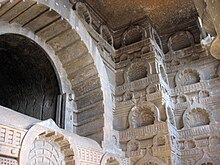Bedsa cave monastery

Bedsa (also: Bhedsa or Bedse ) is a Buddhist cave monastery in the Pune district in the Indian state of Maharashtra .
location
Bedsa is located on an old trade route on the Dekkan Plateau near the Western Ghats ; the cave monasteries of Karli and Bhaja are only a few kilometers away. The next largest city is Lonavla on the Mumbai - Pune railway line . From there or from the local train station Kamshet , the place can be easily reached by taxis or motor rikshas . A subsequent ascent of around 35 m in height and around 200 m in length has to be mastered on foot.
history
Because of the largely unadorned complex, the Buddhist monastery complex dates back to the 1st century BC Dated. The extremely decorative, but figure-less designed entrance area, which has great similarities with the Kondana cave monastery located approx. 30 km (as the crow flies) northwest , could also have been designed later in the 1st or 2nd century AD.
architecture
Entrance area
One of the many attractions of Bedsa is the richly but almost aniconically decorated entrance area to the Chaitya Hall. Large kudu motifs, arranged next to and on top of each other, predominate here, the horseshoe arches of which are filled with foreshortened vaults; the rafter ends of the vaults are visible in the front area. At the top, all arches end in points - formed from two opposing arches - so that the motif of a keel arch , unknown in Europe at that time and also in other early cultures of the Old World, is created. Two mighty octagonal and two half-columns with large, round lotus-shaped capitals, which are still elevated by elephants and - separately on two animals (horse and bull / buffalo) - lovers ( mithunas ) carry the richly relief stone entablature of the entrance hall. The main entrance leads into the main room of the Chaitya Hall; Another portal leads directly into the left aisle, so that the prescribed conversion of the stupa in a clockwise direction was guaranteed.
Chaitya hall

The Chaitya Hall by Bedsa is a three-aisled room with a total of only about 5.5 meters high with - two rows of pillars tilted slightly towards the center - consisting of 26 octagonal, but base - and capitalless columns that meet behind an aniconical stupa , so that the possibility of a distant, d. H. non-contact, transformation ( pradakshina ) of the stupa results. The worked out from the rock Stupa itself is carried in relief fence rows (vedikas) divided into two circular segments of a dome with a cube-shaped and outwardly projecting attachment ( harmika ) and on a stone rod (yasti) seated screen ( Chhatra ) are crowned . The pole and umbrella are often interpreted as a world tree or world axis ( axis mundi ) . In the vaulted roof area, traces of wooden rafters can still be seen, with which the vault - statically and structurally completely insignificant - was once underlaid.

Vihara hall
The Vihara Hall, which is also vaulted as an exception, consists of nine chambers carved into the rock, the entrances of which are covered by blind arches or blind windows ( chandrasalas ) and framed by vertical and horizontal wall templates. Several false grids ( jalis ) are carved into the rock between the wall templates . A relief stone fence ( vedika ) runs between the false windows (kudus) with their foreshortened vaults, the ends of the rafters appearing to protrude within the arch , which - slightly modified - is repeated below the vault. The rear part is - a major exception in Vihara caves - designed semicircular, so that there is a parallel to the Chaitya hall and thus an almost sacred room atmosphere.
Adjoining shrines
About 50 to 100 m west of the main complex there are several smaller - partly also unfinished - caves. One houses an unfinished votive stupa about 2.50 m high, which almost fills the entire room.
photos
See also
literature
- Bernd Rosenheim: The world of the Buddha. Early Buddhist Art Sites in India . Philipp von Zabern, Mainz 2006, ISBN 3-8053-3665-9 .
Web links
- Bedsa Caves - Photos
- Bedsa-Caves - Photos, plan sketch + Infos (Engl.)
- Bedsa-Caves - Photos and brief information (Engl.)
Coordinates: 18 ° 43 ′ 28 ″ N , 73 ° 32 ′ 10 ″ E




